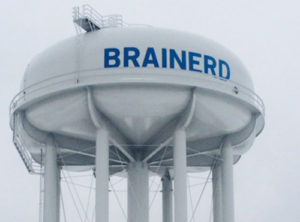
Brainerd Public Utilities began chlorinating its water supply on August 11, 2023 following the guidelines put forth by the Minnesota Department of Health (MDH) for reducing contaminates. The MDH recommends chlorination continue until a residual of .2 free mg/l is detected throughout the BPU’s water distribution system.
Due to safety concerns, Brainerd Public Utilities will no longer be providing customers with non-fluoridated water at the Central Station location (August 11, 2023).

| Disconnect/Reconnect Electricity | |||
| 7:00 a.m. - 3:00 p.m. (dropping lines, meter maintenance, etc) | No Charge | ||
| After hours Emergency Disconnect/Reconnect | No Charge | ||
| Temporary Service-If line is extended additional fees could be incurred | $150.00 | ||
| Disconnected delinquent accounts & Foreclosures - 7:00 a.m. - 3:00 p.m. | $50.00 | ||
| Special Events | |||
| Service Charge (Additional charges could be incurred) | $150.00 | ||
| Electric commercial base service charge per meter | $25.00 | ||
| Commercial kWh charge | $0.10581 | ||
| Turn Off/On Water | |||
| 7:00 a.m - 3:00 p.m. | No Charge | ||
| After hours Emergency Turn Off | No Charge | ||
| Disconnected delinquent accounts & Foreclosures - 7:00 a.m. - 3:00 p.m. | $50.00 | ||
| Tampering With Meter | |||
| Tampering Fee | $350.00 | ||
| Additional Reconnect Fee | $50.00 | ||
| 3 month average deposit | Varies | ||
|
New Water Service-1" (main to curb stop) RESTORATION IS OWNER'S RESPONSIBILITY |
Total Costs Incurred | ||
| Water Main Tap | |||
| 3/4" or 1" plus materials | $300.00 | ||
| 1 1/2" or 2" plus materials | $600.00 | ||
| Water Transmitter | $140.00 | ||
| Water Meters | |||
| 5/8" - 1/2" Iperl | $275.00 | ||
| 3/4" Iperl | $275.00 | ||
| 1" Iperl | $380.00 | ||
| 1 1/2" Omni-C2 | $2170.00 | ||
| 2" Omni-C2 | $2505.00 | ||
| 3" Omni-C2 | $3175.00 | ||
| 4" Omni T2 | $5510.00 | ||
| Bulk Water Sales | |||
| Service Charge | $23.16 | ||
| Charge per 1,000 gallons | $4.92 | ||
| Hydrant Meter Deposit - (Refundable) | $1,000.00 | ||
| Pole Attachments - annually per pole | $7.00 | ||
| Security Lights - monthly per light | $12.50 + sales tax | ||
| No charge to install if installed on existing pole | |||
| Oversize Loads | |||
| Under $500 estimate | Full estimate before move | ||
| Over $500 estimate | $500 + 50% of est. cost over $500 | ||
| BPU Equipment and Employees | |||
| Hourly Rate Per Employee | $70.70/hr | ||
| After Hours Hourly Rate Per Employee | $106.05/hr | ||
| Materials | Materials + 20% & sales tax | ||
| Truck | $100/day | ||
| Backhoe | $45/hr | ||
| Generator | $950/day + fuel | ||